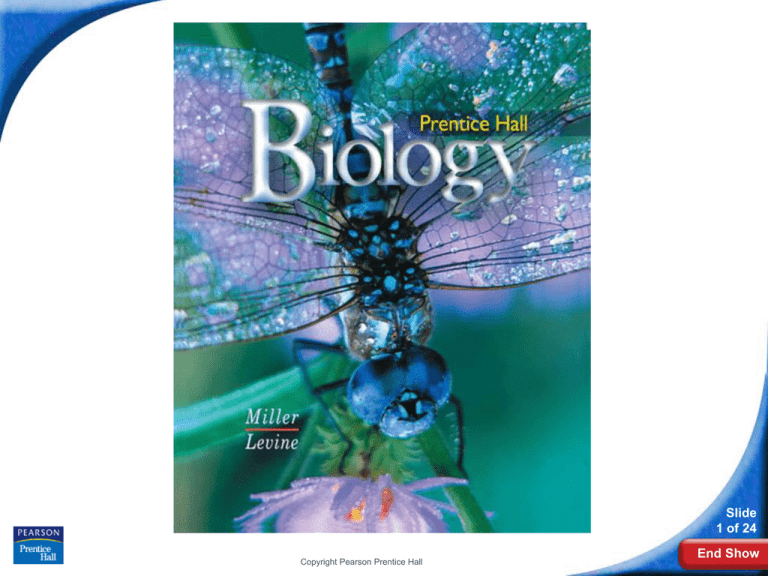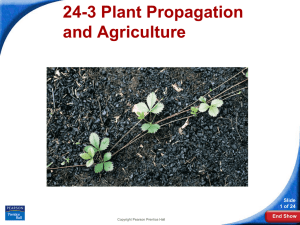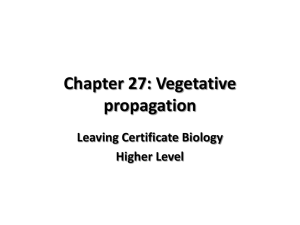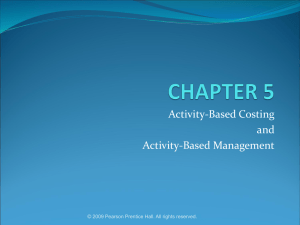
Biology
Slide
1 of 24
Copyright Pearson Prentice Hall
End Show
24-3 Plant Propagation
and Agriculture
Slide
2 of 24
Copyright Pearson Prentice Hall
End Show
24-3 Plant Propagation and
Agriculture
Vegetative Reproduction
Vegetative Reproduction
Vegetative reproduction is a method of asexual
reproduction used by flowering plants.
Vegetative reproduction enables a single plant to
produce many offspring genetically identical to
itself.
Slide
3 of 24
Copyright Pearson Prentice Hall
End Show
24-3 Plant Propagation and
Agriculture
Vegetative Reproduction
What forms of vegetative reproduction
occur in plants?
Slide
4 of 24
Copyright Pearson Prentice Hall
End Show
24-3 Plant Propagation and
Agriculture
Vegetative Reproduction
Vegetative reproduction includes the
production of new plants from
horizontal stems, from plantlets, and
from underground roots.
Slide
5 of 24
Copyright Pearson Prentice Hall
End Show
24-3 Plant Propagation and
Agriculture
Vegetative Reproduction
Some angiosperms produce tiny plants, or plantlets,
at the tips of elongated stems.
Slide
6 of 24
Copyright Pearson Prentice Hall
End Show
24-3 Plant Propagation and
Agriculture
Vegetative Reproduction
Other plants grow horizontal stems. These long
trailing stems, called stolons, produce roots when
they touch the ground.
Slide
7 of 24
Copyright Pearson Prentice Hall
End Show
24-3 Plant Propagation and
Agriculture
Vegetative Reproduction
Once the roots are well established, each stolon may
be broken, forming a new independent plant.
Slide
8 of 24
Copyright Pearson Prentice Hall
End Show
24-3 Plant Propagation and
Agriculture
Plant Propagation
What is plant propagation?
Slide
9 of 24
Copyright Pearson Prentice Hall
End Show
24-3 Plant Propagation and
Agriculture
Plant Propagation
Plant Propagation
In plant propagation, horticulturists use
cuttings, grafting, or budding to make
many identical copies of a plant or to
produce offspring from seedless plants.
Slide
10 of 24
Copyright Pearson Prentice Hall
End Show
24-3 Plant Propagation and
Agriculture
Plant Propagation
Cuttings
One of the simplest ways to reproduce plants
vegetatively is by cuttings.
A grower “cuts” a plant stem that includes buds
containing meristematic tissue.
That stem is then partially buried in soil or in a
special rooting mixture.
Some plants are treated with rooting powders to
help them grow.
Slide
11 of 24
Copyright Pearson Prentice Hall
End Show
24-3 Plant Propagation and
Agriculture
Plant Propagation
Grafting and Budding
Grafting and budding are used to reproduce
seedless plants and varieties of woody plants that
do not produce strong root systems.
A piece of stem or a lateral bud is cut from the
parent plant and attached to another plant.
Slide
12 of 24
Copyright Pearson Prentice Hall
End Show
24-3 Plant Propagation and
Agriculture
Plant Propagation
The cut piece is called the scion, and the plant to
which it is attached is called the stock.
When stems are used as scions, the process is
called grafting.
When buds are used as scions, the process is called
budding.
Slide
13 of 24
Copyright Pearson Prentice Hall
End Show
24-3 Plant Propagation and
Agriculture
Agriculture
Agriculture
Agriculture is the systematic cultivation of plants.
Slide
14 of 24
Copyright Pearson Prentice Hall
End Show
24-3 Plant Propagation and
Agriculture
Agriculture
Which crops are the major food supply
for humans?
Slide
15 of 24
Copyright Pearson Prentice Hall
End Show
24-3 Plant Propagation and
Agriculture
Agriculture
Worldwide Patterns of Agriculture
Most of the people of the world depend on a
few crop plants, such as wheat, rice, and
corn, for the bulk of their food supply.
Roughly 80 percent of all U.S. cropland is
used to grow wheat, corn, soybeans, and
hay.
Slide
16 of 24
Copyright Pearson Prentice Hall
End Show
24-3 Plant Propagation and
Agriculture
Agriculture
Changes in Agriculture
The efficiency of agriculture has been improved
through:
• improvements in farming techniques
• the selective breeding of crop plants
Selective breeding allows only organisms with
certain traits to produce the next generation.
Slide
17 of 24
Copyright Pearson Prentice Hall
End Show
24-3 Plant Propagation and
Agriculture
Agriculture
Improvements in farming techniques have
contributed to dramatic improvements in crop yields.
Some of the most important techniques have been
the use of pesticides and fertilizers.
Slide
18 of 24
Copyright Pearson Prentice Hall
End Show
24-3
Click to Launch:
Continue to:
- or -
Slide
19 of 24
End Show
Copyright Pearson Prentice Hall
24-3
Which of the following is a method of vegetative
reproduction?
a. pollination
b. seed dispersal
c. plantlet production
d. fertilization
Slide
20 of 24
End Show
Copyright Pearson Prentice Hall
24-3
Long, trailing stems that can produce roots are
called
a. scions.
b. stolons.
c. cuttings.
d. buds.
Slide
21 of 24
End Show
Copyright Pearson Prentice Hall
24-3
In order to propagate a plant by cuttings, the
cuttings must include
a. roots, stems, and leaves.
b. xylem and phloem.
c. meristematic tissue.
d. ground tissue.
Slide
22 of 24
End Show
Copyright Pearson Prentice Hall
24-3
The process in which a stem is used as a scion
is called
a. grafting.
b. budding.
c. stock.
d. stolon.
Slide
23 of 24
End Show
Copyright Pearson Prentice Hall
24-3
Crops used as food by the bulk of the world
include all of the following EXCEPT
a. corn.
b. wheat.
c. rice.
d. potatoes.
Slide
24 of 24
End Show
Copyright Pearson Prentice Hall
END OF SECTION







